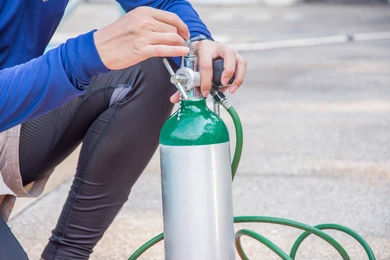Oxygen Tank vs. Oxygen Concentrator: Which is Better for Emergency Use in Malaysia?
- Nabiha A.
- 21 Mac
- 3 min membaca
Index:
Introduction: Choosing the Right Oxygen Supply During a Medical Emergency
When someone experiences shortness of breath, low oxygen saturation, or a respiratory emergency, having quick access to supplemental oxygen can be life-saving. In Malaysia, many families are unsure whether to choose an oxygen tank or an oxygen concentrator for emergency use at home.
In this guide, we break down the key differences, benefits, and limitations of both options to help you make the best decision based on cost, availability, safety, and emergency readiness.
What Is an Oxygen Tank?
An oxygen tank is a metal cylinder filled with compressed medical-grade oxygen.
Pros:
✅ Immediate oxygen supply (no electricity needed).
✅ Portable (especially smaller tanks).
✅ Good for short-term or mobile use.
Cons:
❌ Limited oxygen supply (runs out and needs refilling).
❌ Heavy and bulky in larger sizes.
❌ Fire risk due to compressed gas.
❌ Requires monitoring of oxygen level gauge.
What Is an Oxygen Concentrator?
An oxygen concentrator is a medical device that pulls in ambient air, filters out nitrogen, and delivers concentrated oxygen to the patient.
Pros:
✅ Unlimited oxygen (as long as electricity is available).
✅ No need for refills or storage of compressed gas.
✅ Safer for long-term and in-home use.
✅ Available in portable or home-use models.
Cons:
❌ Requires electricity or battery to operate.
❌ May produce low background noise.
❌ Slightly higher upfront cost (though affordable rentals exist).
Emergency Use in Malaysia: What Matters Most?
In a country like Malaysia, where emergency oxygen access is often needed quickly at home, here’s how both options compare:
Feature | Oxygen Tank | Oxygen Concentrator |
Availability | Limited stock, needs refills | Widely available, no refills needed |
Emergency Use | Immediate use without power | Requires power, but no setup delays |
Delivery Time | 4–8 hours depending on provider | As fast as 4 hours from rental services |
Running Time | Limited (1–4 hours per tank) | Continuous as long as powered |
Cost | Lower initial cost but recurring refills | RM250/month rentals in Malaysia |
Portability | Good (small tanks) | Available in portable versions |
Did You Know?
📌 Oxygen concentrators can deliver up to 95% pure oxygen without storing compressed gas.
📌 Oxygen tanks must be handled with care, as they are under high pressure and flammable.
📌 Portable concentrators are allowed on airplanes with doctor approval and battery supply.
📌 RM250/month concentrator rentals are now available in major cities like Kuala Lumpur.
Where to Rent or Buy in Malaysia
You can rent or purchase oxygen equipment from certified medical suppliers:
OxiHome - en.oksigen.my
Lazada & Shopee (Verified Sellers) – Portable concentrators available.
Hospitals & Clinics – For urgent prescriptions and setup.
💡 Pro Tip: Always ensure your provider offers certified medical-grade equipment and 4-hour emergency delivery options.
Conclusion: Which Should You Choose for Emergencies?
If you need quick, short-term oxygen access, an oxygen tank is a good option. However, for long-term care, convenience, and safety, an oxygen concentrator is the better choice—especially with affordable rental plans and fast delivery in Malaysia.
✅ Tanks = good for mobility & power outages
✅ Concentrators = best for continuous, safe, long-term use
👉 Next Step: Consult your doctor and choose a provider offering fast delivery & certified equipment to keep your loved ones safe.
FAQs: Your Questions Answered
1. Which is safer: oxygen tank or concentrator?
Oxygen concentrators are generally safer for home use as they don’t involve pressurized gas.
2. What if there’s a power outage?
For concentrators, consider a backup power source or battery unit. In emergencies, oxygen tanks are reliable.
3. How fast can I get an oxygen concentrator in Malaysia?
Some providers offer 4-hour delivery, especially in urban areas like Klang Valley.
4. Do I need a prescription?
Yes. Both options typically require a doctor’s prescription to ensure proper oxygen flow settings.
5. Which option is cheaper long-term?
While tanks may seem cheaper initially, oxygen concentrators save more over time with no refill costs.






Komen